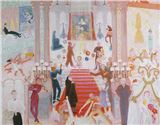Christopher Provenzano: Dead Man's Island
Marvin Gardens gladly presents вҖңDead ManвҖҷs Island,вҖқ a solo exhibition of new paintings by Christopher Provenzano. The artist loosely takes the title from research of different places on the globe with the same name, and remembering the 1996 made for television movie.
Like most of ProvenzanoвҖҷs references -and influences- the connection is anything but direct, if readable at all. They serve rather as a loose associative framework from which to construct the imagery. These new paintings continue his exploration of flattened out spare compositions, imbued with a striking stillness.
In different ways, most of the works display a version of a painted or drawn border. This border hovers between holding compositional stillness in an architectural sense, and hinting at movement in a filmic frame-space. This view is supported by the flattened vocabulary of screens in the videogame-style rendering of the topiary in Pillar, and in the painting sharing the title of the show: Dead ManвҖҷs Island, via the graphic qualities of the line of fire and in the varying greens.
The specificity of color the artist notes, is taken largely from what he would choose to surround himself with in life and look for in clothing. This disclosure provides an interesting example of how he twists in and out of painting images today within the intersection of abstraction and figuration, in one sense imbuing painting with figuration via color. This is addressed in the painting Dead ManвҖҷs Island. Here, a number of hands (sourced from art-historical paintings) take the place of torsos for two bodies. Flattened out into two or three colors, they become abstracted and more glove-like, an interesting reiteration of color choice and painting style being tied to what covers the human form.

Recommended for you
Marvin Gardens gladly presents вҖңDead ManвҖҷs Island,вҖқ a solo exhibition of new paintings by Christopher Provenzano. The artist loosely takes the title from research of different places on the globe with the same name, and remembering the 1996 made for television movie.
Like most of ProvenzanoвҖҷs references -and influences- the connection is anything but direct, if readable at all. They serve rather as a loose associative framework from which to construct the imagery. These new paintings continue his exploration of flattened out spare compositions, imbued with a striking stillness.
In different ways, most of the works display a version of a painted or drawn border. This border hovers between holding compositional stillness in an architectural sense, and hinting at movement in a filmic frame-space. This view is supported by the flattened vocabulary of screens in the videogame-style rendering of the topiary in Pillar, and in the painting sharing the title of the show: Dead ManвҖҷs Island, via the graphic qualities of the line of fire and in the varying greens.
The specificity of color the artist notes, is taken largely from what he would choose to surround himself with in life and look for in clothing. This disclosure provides an interesting example of how he twists in and out of painting images today within the intersection of abstraction and figuration, in one sense imbuing painting with figuration via color. This is addressed in the painting Dead ManвҖҷs Island. Here, a number of hands (sourced from art-historical paintings) take the place of torsos for two bodies. Flattened out into two or three colors, they become abstracted and more glove-like, an interesting reiteration of color choice and painting style being tied to what covers the human form.













